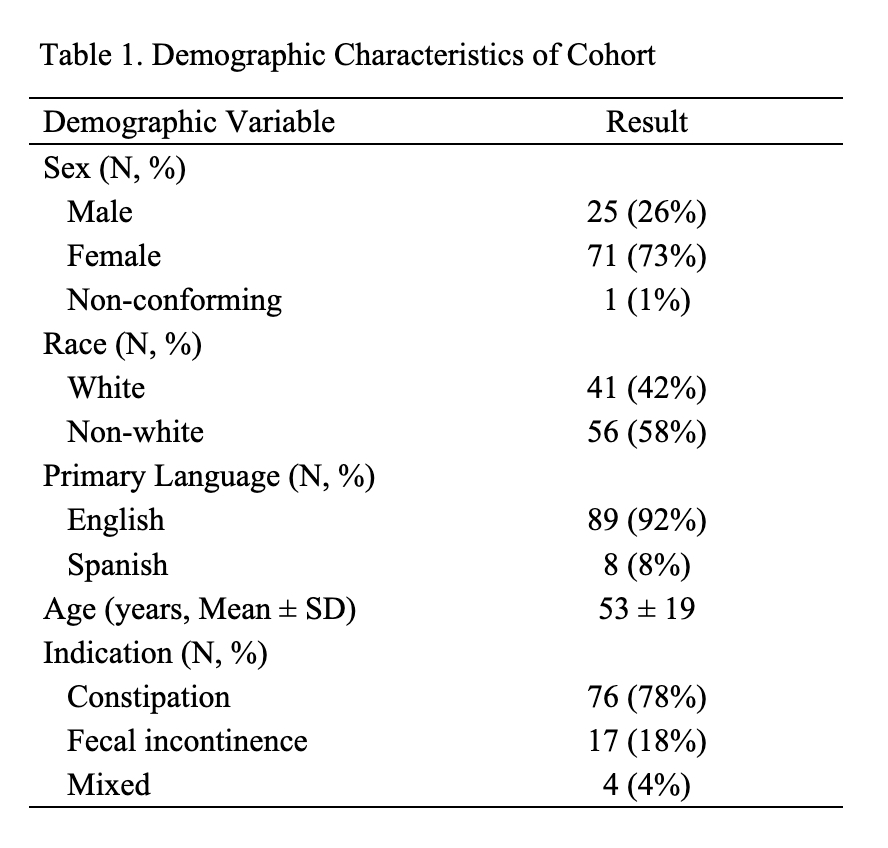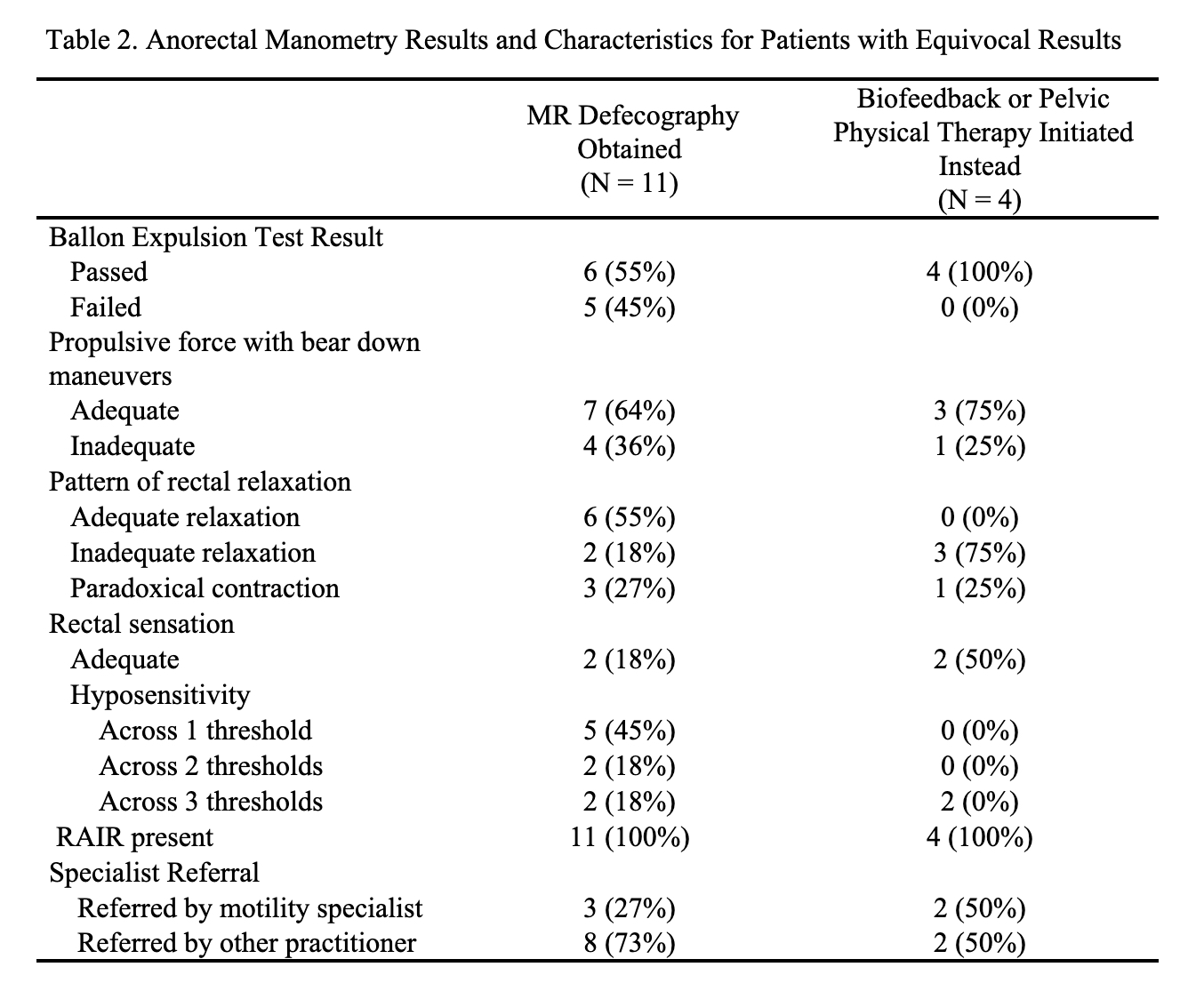Monday Poster Session
Category: Functional Bowel Disease
P2956 - In the Gray Zone: Post-Diagnostic Journeys of Patients With Equivocal Anorectal Manometry Results
Monday, October 27, 2025
10:30 AM - 4:00 PM PDT
Location: Exhibit Hall
- MH
Madison R. Heath, MD (she/her/hers)
Icahn School of Medicine at Mount Sinai
New York, NY
Presenting Author(s)
Madison R. Heath, MD1, Priyanka Singh, MD, MS2, Yuying Luo, MD3
1Icahn School of Medicine at Mount Sinai, New York, NY; 2Elmhurst Hospital Center / Icahn School of Medicine at Mount Sinai, New York, NY; 3Mount Sinai West & Morningside, New York, NY
Introduction: Anorectal manometry (ARM) with balloon expulsion testing (BET) is an important tool for evaluating defecatory disorders. When ARM and BET results are equivocal, patients are often recommended MR defecography for further evaluation, although it is unclear what proportion of patients proceed with additional testing.
Methods: This was a retrospective study of all patients who obtained an ARM and BET between January and March 2024 at a single tertiary care center. Our primary outcome was the percentage of patients who underwent MR defecography within one year of equivocal anorectal manometry results.
Results: Of the 97 included participants, 71 (73%) were female, 41 (42%) were white [Table 1]. A total of 76 (78%) were referred for constipation, 17 (18%) were referred for fecal incontinence, and 4 (4%) had both. Of these, 24 (25%) had equivocal results and MR defecography was recommended. Within the following year, 11 (46%) of those recommended for MR defecography had obtained the imaging, 4 (17%) went directly to biofeedback and/or pelvic physical therapy instead, 8 (33%) were lost to follow-up, and 1 (4%) decided to try an alternative treatment. Of the 11 patients who underwent MR defecography, 6 (55%) passed the balloon expulsion test, 9 (82%) had rectal hyposensitivity, and 3 (27%) were referred by a motility specialist [Table 2]. Additionally, based on the results of MR defecography for these patients, 7 (64%) started or planned for pelvic floor physical therapy/biofeedback therapy, 1 (8%) did not demonstrate findings warranting biofeedback or pelvic physical therapy, and 3 (25%) were lost to follow up.
Discussion: Less than half of the patients referred for MR defecography obtained imaging within one year after equivocal ARM and BET results. Clinicians should carefully consider who may ultimately benefit from MR defecography versus an early referral for biofeedback or pelvic physical therapy, as many patients may not obtain additional testing.

Figure: Demographic Characteristics of Cohort

Figure: Anorectal Manometry Results and Characteristics for Patients with Equivocal Results
Disclosures:
Madison Heath indicated no relevant financial relationships.
Priyanka Singh indicated no relevant financial relationships.
Yuying Luo: Ardelyx – Grant/Research Support.
Madison R. Heath, MD1, Priyanka Singh, MD, MS2, Yuying Luo, MD3. P2956 - In the Gray Zone: Post-Diagnostic Journeys of Patients With Equivocal Anorectal Manometry Results, ACG 2025 Annual Scientific Meeting Abstracts. Phoenix, AZ: American College of Gastroenterology.
1Icahn School of Medicine at Mount Sinai, New York, NY; 2Elmhurst Hospital Center / Icahn School of Medicine at Mount Sinai, New York, NY; 3Mount Sinai West & Morningside, New York, NY
Introduction: Anorectal manometry (ARM) with balloon expulsion testing (BET) is an important tool for evaluating defecatory disorders. When ARM and BET results are equivocal, patients are often recommended MR defecography for further evaluation, although it is unclear what proportion of patients proceed with additional testing.
Methods: This was a retrospective study of all patients who obtained an ARM and BET between January and March 2024 at a single tertiary care center. Our primary outcome was the percentage of patients who underwent MR defecography within one year of equivocal anorectal manometry results.
Results: Of the 97 included participants, 71 (73%) were female, 41 (42%) were white [Table 1]. A total of 76 (78%) were referred for constipation, 17 (18%) were referred for fecal incontinence, and 4 (4%) had both. Of these, 24 (25%) had equivocal results and MR defecography was recommended. Within the following year, 11 (46%) of those recommended for MR defecography had obtained the imaging, 4 (17%) went directly to biofeedback and/or pelvic physical therapy instead, 8 (33%) were lost to follow-up, and 1 (4%) decided to try an alternative treatment. Of the 11 patients who underwent MR defecography, 6 (55%) passed the balloon expulsion test, 9 (82%) had rectal hyposensitivity, and 3 (27%) were referred by a motility specialist [Table 2]. Additionally, based on the results of MR defecography for these patients, 7 (64%) started or planned for pelvic floor physical therapy/biofeedback therapy, 1 (8%) did not demonstrate findings warranting biofeedback or pelvic physical therapy, and 3 (25%) were lost to follow up.
Discussion: Less than half of the patients referred for MR defecography obtained imaging within one year after equivocal ARM and BET results. Clinicians should carefully consider who may ultimately benefit from MR defecography versus an early referral for biofeedback or pelvic physical therapy, as many patients may not obtain additional testing.

Figure: Demographic Characteristics of Cohort

Figure: Anorectal Manometry Results and Characteristics for Patients with Equivocal Results
Disclosures:
Madison Heath indicated no relevant financial relationships.
Priyanka Singh indicated no relevant financial relationships.
Yuying Luo: Ardelyx – Grant/Research Support.
Madison R. Heath, MD1, Priyanka Singh, MD, MS2, Yuying Luo, MD3. P2956 - In the Gray Zone: Post-Diagnostic Journeys of Patients With Equivocal Anorectal Manometry Results, ACG 2025 Annual Scientific Meeting Abstracts. Phoenix, AZ: American College of Gastroenterology.
